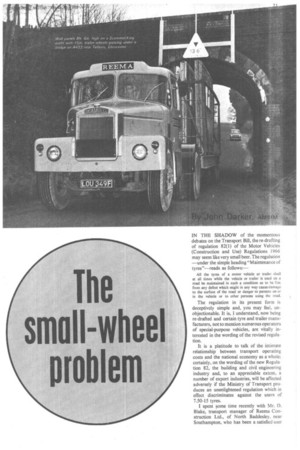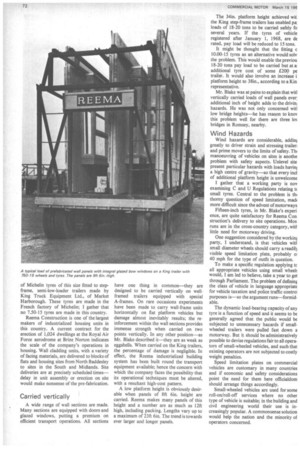IN THE SHADOW of the momentous debates on the Transport
Page 73

Page 74

If you've noticed an error in this article please click here to report it so we can fix it.
Bill, there-drafting of regulation 82(1) of the Motor Vehicles (Construction and Use) Regulations 1966 may seem like very small beer. The regulation —under the simple heading "Maintenance of tyres"—reads as follows:— All the tyres of a motor vehicle or trailer shall at all times while the vehicle or trailer is used on a road be maintained in such a condition as to be free from any defect which might in any way cause damage to the surface of the road or danger to persons on or in the vehicle or to other persons using the road.
The regulation in its present form is deceptively simple and, you may feel, unobjectionable. It is, I understand, now being re-drafted and certain tyre and trailer manufacturers, not to mention numerous operators of special-purpose vehicles, are vitally interested in the wording of the revised regulation.
It is a platitude to talk of the intimate relationship between transport operating costs and the national economy as a whole: certainly, on the wording of the new Regulation 82, the building and civil engineering industry and, to an appreciable extent, a number of export industries, will be affected adversely if the Ministry of Transport produces an unenlightened regulation which in effect discriminates against the users of 7.50-15 tyres.
I spent some time recently with Mr. D. Blake, transport manager of Reema Construction Ltd., of North Baddesley, near Southampton, who has been a satisfied user of Michelin tyres of this size fitted to stepframe, semi-low-loader trailers made by King Truck Equipment Ltd., of Market Harborough. These tyres are made in the French factory of Michelin; I gather that no 7.50-15 tyres are made in this country.
Reema Construction is one of the largest makers of industrialized housing units in this country. A current contract for the erection of 1,024 dwellings at the Royal Air Force aerodrome at Brize Norton indicates the scale of the company's operations in housing. Wall cladding units, with a variety of facing materials, are delivered to blocks of flats and housing sites from North Baddesley to sites in the South and Midlands. Site deliveries are at precisely scheduled times— delay in unit assembly or erection on site would make nonsense of the pre-fabrication.
Carried vertically
A wide range of wall sections are made. Many sections are equipped with doors and glazed windows, putting a premium on efficient transport operations. All sections have one thing in common—they are designed to be carried vertically on wellframed trailers equipped with special A-frames. On rare occasions experiments have been made to carry wall-frame units horizontally on flat platform vehicles but damage almost inevitably results; the reinforcement within the wall sections provides immense strength when carried on two points vertically. In any other position—as Mr. Blake described it—they are as weak as eggshells. When carried on the King trailers, the percentage of damage is negligible. In effect, the Reema industrialized building system has been built round the transport equipment available; hence the concern with which the company faces the possibility that its operational techniques must be altered, with a resultant high-cost pattern.
A low platform height is obviously desirable when panels of 8ft 6in. height are carried. Reema makes many panels of this height and a number are as much as 12ft high, including packing. Lengths vary up to a maximum of 23ft 6in. The trend is towards ever larger and longer panels. The 34in. platform height achieved wit the King step-frame trailers has enabled pa; loads of 18-20 tons to be carried safely fo several years. If the tyres of vehicle registered after January 1, 1968, are de rated, pay load will be reduced to 15 tons.
It might be thought that the fitting c 10.00-15 tyres as an alternative would solv the problem. This would enable the previou 18-20 tons pay load to be carried but at a: additional tyre cost of some £200 pe trailer. It would also involve an increase i platform height to 38in., according to a Kin representative.
Mr. Blake was at pains to explain that witl vertically carried loads of wall panels ever: additional inch of height adds to the drivin; hazards. He was not only concerned wit] low bridge heights—he has reason to knov this problem well for there are three loN bridges in Romsey, nearby.
Wind Hazards
Wind hazards are considerable, addini greatly to driver strain and stressing trailer: and prime movers to the limits of safety. Thc manoeuvring of vehicles on sites is anothe problem with safety aspects. Unlevel site present particular hazards with loads havinl a high centre of gravity—so that every incl of additional platform height is unwelcome I gather that a working party is nov examining C and U Regulations relating tt small tyres. Central to the problem is tilt thorny question of speed limitation, mad( more difficult since the advent of motorways Fifteen-inch tyres, in Mr. Blake's experi ence, are quite satisfactory for Reema Con struction's delivery to site operations. Mos runs are in the cross-country category, witi little need for motorway driving.
One suggestion considered by the workini party, I understand, is that vehicles witl small diameter wheels should carry a readil3 visible speed limitation plate, probably ol 40 mph for the type of outfit in question.
To make a specific regulation applying tc all appropriate vehicles using small wheel:
would, I am led to believe, take a year to get
through Parliament. The problem of definini the class of vehicle in language appropriate for vehicle taxation and police traffic control purposes is—so the argument runs—formidable.
The dynamic load-bearing capacity of any tyre is a function of speed and it seems to be generally agreed that the public would be subjected to unnecessary hazards if smallwheeled trailers were pulled fast down a motorway. But it should be administratively possible to devise regulations fair to all operators of small-wheeled vehicles, and such that existing operators are not subjected to costly weight penalties.
Speed limitation plates on commercial vehicles are customary in many countries and if economic and safety considerations point the need for them here officialdom should arrange things accordingly.
Small-wheeled vehicles are used for some roll-on/roll-off services where no other type of vehicle is suitable; in the building and civil engineering world their use is increasingly popular. A commonsense solution would help the nation and the minority of operators concerned.




































































































































